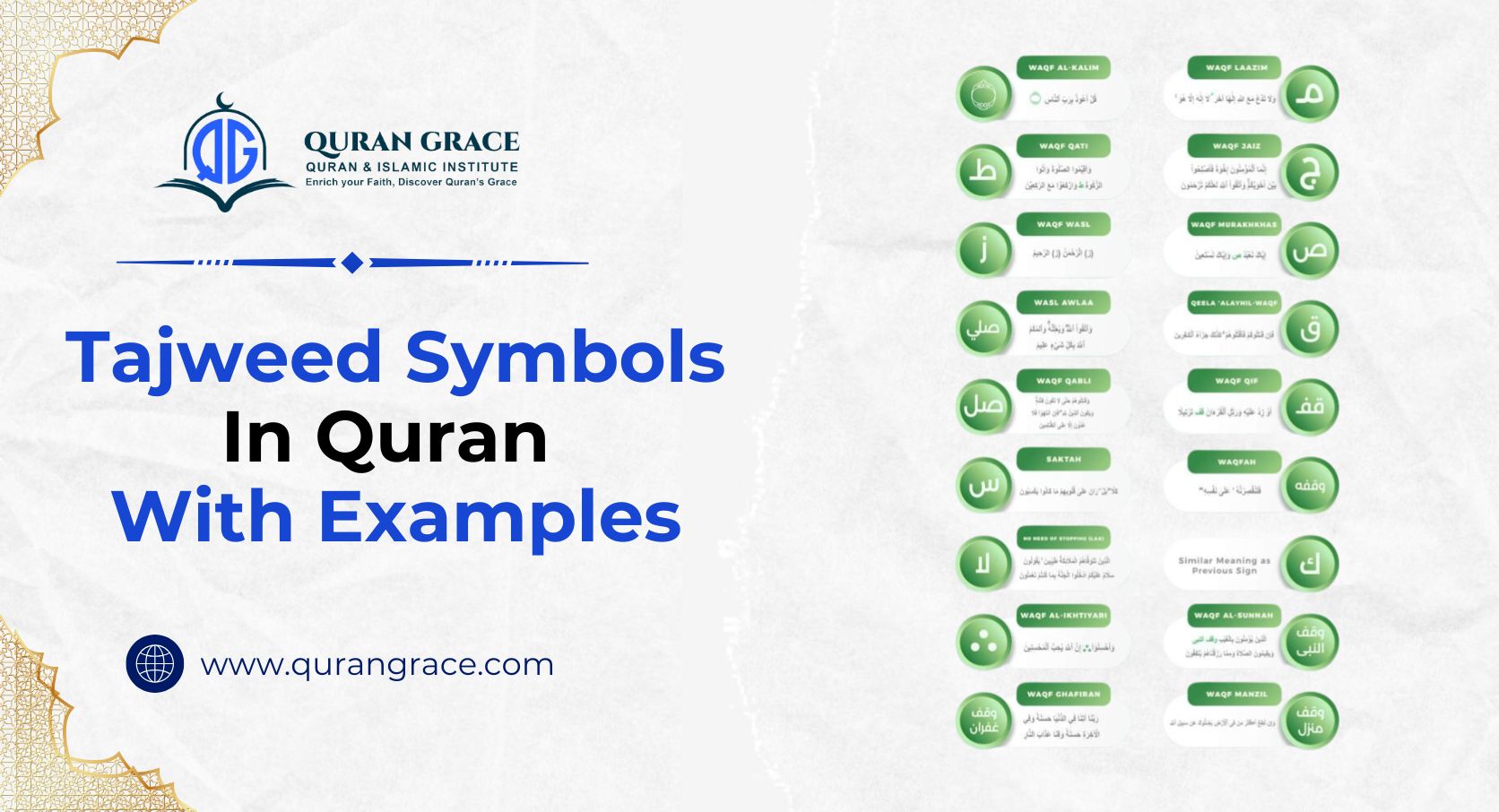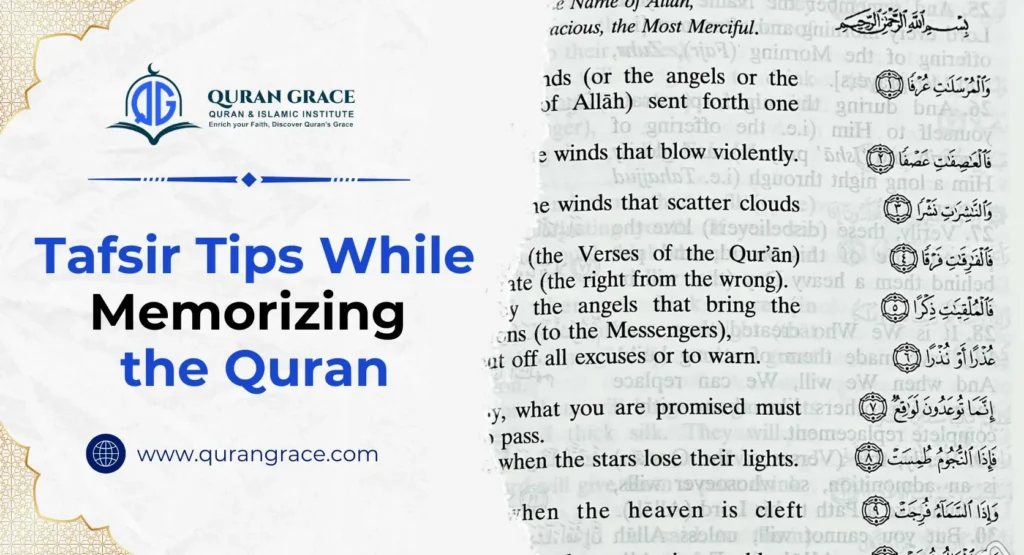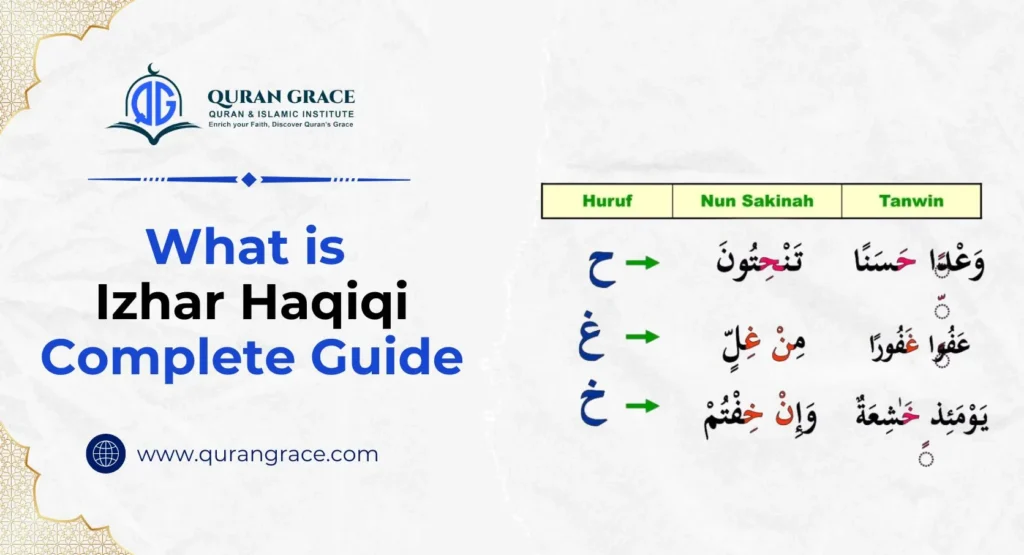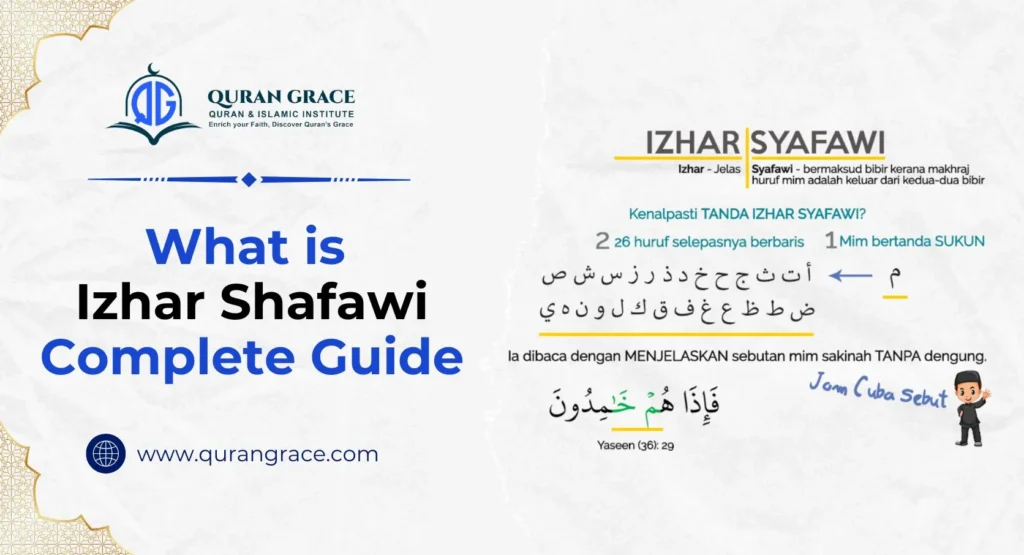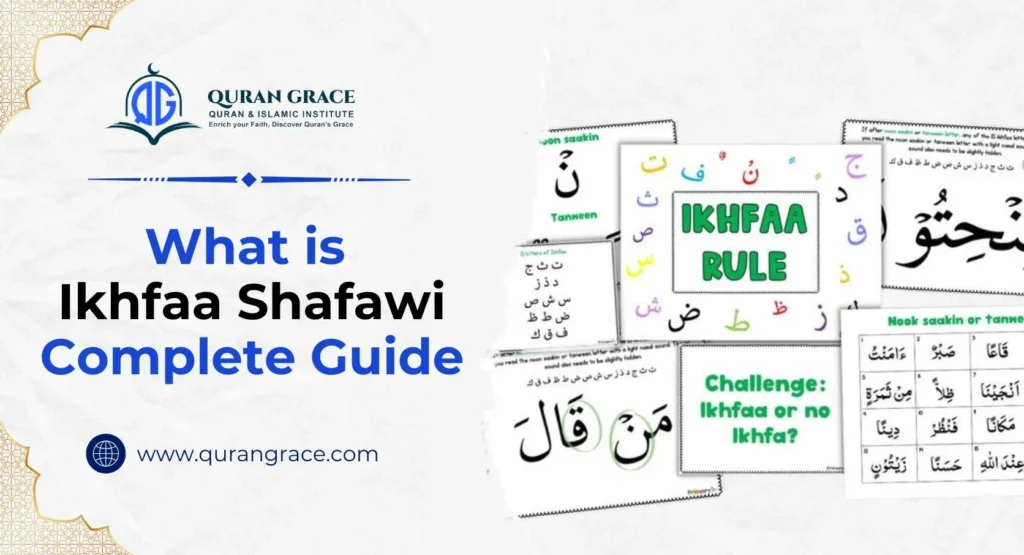Tajweed symbols in the Quran guide readers on where to stop, pause, or continue during recitation. These marks help preserve the meaning and beauty of the verses. In this article, we’ll cover key Tajweed symbols like , مـ, ط, ج, ص, لا and more, with clear explanations to understand tajweed rules with symbols properly. Whether you’re new or advancing in your recitation, understanding these signs is essential for anyone taking Quran Tajweed lessons.
Table of Contents
Toggle1. The Conclusion of Verse (Waqf al-Kalim)
The symbol , which appears as a small circle at the end of the verse, indicates that you have reached the end of a specific thought. It serves a similar purpose to a full stop (.) at the end of a sentence in English.
At this point, it is helpful to take a moment to pause, breathe, and reflect on the meaning of what you just read. This pause allows the message of the verse to settle in before you continue. You can think of it as taking a brief break between stanzas in a poem to truly appreciate its beauty.
Example: قُلْ هُوَ ٱللَّهُ أَحَدٌ
2. مـ – The Compulsory Stop (Waqf Laazim)
The symbol مـ indicates a mandatory stop, similar to a red traffic light. It is essential to pause at this point, as continuing to recite without stopping can significantly alter the meaning of the verse. This pause serves as a critical separator between two important ideas. You can think of it as analogous to a comma in the phrase “Stand not, sit!” This helps clarify the message being conveyed.
Example: وَلَا تَدْعُ مَعَ اللَّهِ إِلَٰهًا آخَرَ ۘ لَا إِلَٰهَ إِلَّا هُوَ
3. ط – The Absolute Pause (Waqf Qati)
Like مـ, the symbol (ط) represents a noticeable pause, but with more emphasis. In this case, you not only pause but also lower your voice a bit. It signals a clear change in the subject or adds a dramatic touch to the verse. Additionally, it plays a role in the rules concerning Meem Sakinah.
Example: وَاَقِيۡمُوا الصَّلٰوةَ وَاٰتُوا الزَّكٰوةَ ط وَارۡكَعُوۡا مَعَ الرّٰكِعِيۡنَ
4. ج – The Permissible Stop (Waqf Jaiz)
The symbol (ج) serves as a guideline for pausing during recitation, though it is not obligatory. The decision to pause at this point depends on your breathing patterns or your intention to emphasize specific words within the verse. This allows for a degree of flexibility in how the verse is recited. Additionally, it is beneficial to familiarize yourself with the Idghaam rules in Tajweed to enhance your recitation skills.
Example: إِنَّمَا ٱلۡمُؤۡمِنُونَ إِخۡوَةٞ فَأَصۡلِحُواْ بَيۡنَ أَخَوَيۡكُمۡۚ وَٱتَّقُواْ ٱللَّهَ لَعَلَّكُمۡ تُرۡحَمُونَ
5. ز – Continue Reading (Waqf Wasl)
The symbol (ز) indicates that the reader should continue without pausing. It is used in contexts where the meaning transitions smoothly between words or phrases. Pausing at this point could disrupt the flow of the recitation and potentially change the intended meaning. Therefore, it is advisable to maintain a continuous reading to preserve the rhythm and clarity.
Example: (ز) الَّرَّحْمَنُ (ز) الرَّحِيمُ
6. ص – The Licensed Pause (Waqf Murakhkhas)
The symbol ص denotes a permissible pause during recitation. Similar to the Waqf Jaiz (ج), pausing at this point is not mandatory. It can be likened to a yellow traffic light, offering a moment of caution but with more flexibility. This pause allows the reciter to take a breath or add emphasis without altering the overall meaning of the text. As a result, it provides an opportunity for varied recitation styles while maintaining clarity.
Example: إِيَّاكَ نَعْبُدُ ص وَإِيَّاكَ نَسْتَعِينُ
7. صلي – Preference for Continuation (Wasl Awlaa)
This symbol, صلي, isn’t as common as others but indicates where continuing the recitation is preferable to stopping. While a short pause might be possible, it’s generally discouraged because it could disrupt the flow of the verse.
Key points:
- It is better to continue than to pause.
- Stopping could disrupt the meaning’s organic flow.
- If you must pause, it should be very brief.
Example: وَٱتَّقُواْ ٱللَّهَۖ وَيُعَلِّلَّهُۗ وَٱلمُكُمُ ٱللَّهُ بِكُلِّ شَيۡءٍ عَلِيمٞ
8. ق – Better not to Stop (Qeela ‘Alayhil-Waqf)
The symbol (ق) serves as a guideline indicating that stopping is discouraged, though it is not a strict prohibition like Waqf Laazim (مـ). While it is technically permissible to pause at this point, doing so is generally discouraged because it may disrupt the overall meaning of the verse.
Key points:
- Stopping is discouraged but not completely forbidden.
- If a pause is unavoidable, it should be kept to a minimum.
- Continuing without pause is preferred to maintain a smoother flow of the verse.
Example: فَإِن قَـٰتَلُوكُمْ فَٱقْتُلُوهُمْ ۗ كَذَٰلِكَ جَزَآءُ ٱلْكَـٰفِرِينَ
9. صل – The Permissible Pause (Waqf Qabli)
The symbol صل (Waqf Qabli) is an important notation in Arabic text, especially in the context of recitation. It signifies a point where a pause is permitted, echoing some elements of Waqf Murakhkhas (ص). However, there is a key distinction between the two. While Waqf Murakhkhas allows for a brief pause primarily intended for breath control, Waqf Qabli permits a longer pause. This extended pause can be used for emphasis or to enhance the artistic delivery of the text. Understanding these nuances is essential for effective recitation.
Example: وَقَـٰتِلُوهُمْ حَتَّىٰ لَا تَكُونَ فِتْنَةٌۭ وَيَكُونَ ٱلدِّينُ لِلَّهِ ۖ فَإِنِ ٱنتَهَوْا۟ فَلَا عُدْوَٰنَ إِلَّا عَلَى ٱلظَّـٰلِمِينَ
10. قف – The Anticipation Mark (Waqf Qif)
The symbol قف (Waqf Qif) serves a purpose similar to that of a pause button, generating a sense of anticipation in the text. It indicates a point where the reader should pause, but unlike the Waqf Laazim (مـ), this pause does not signify the conclusion of a complete thought. Instead, it provides a dramatic pause, allowing for a moment of reflection before continuing with a related idea.
Example: أَوْ زِدْ عَلَيْهِ وَرَتِّلِ ٱلْقُرْءَانَ قف تَرْتِيلًا.
11. س – The Silence Symbol (Saktah)
The symbol س (Saktah) represents a brief pause within a verse, comparable to a compulsory stop but shorter in duration. It serves a purpose similar to a comma in English, allowing for a slight break for breath or the separation of ideas within a sentence. This notation helps in maintaining the flow of recitation while ensuring clarity in the delivery of the text.
Example: كَلَّا ۖ بَلْ ۜ رَانَ عَلَىٰ قُلُوبِهِمْ مَا كَانُوا يَكْسِبُونَ
12. لا – No stop (Laa)
The symbol (لا) signifies that a pause should be avoided. It is utilized in contexts where stopping could interrupt the flow of the verse or change its intended meaning.
Example: الَّذِينَ تَتَوَفَّاهُمُ الْمَلَائِكَةُ طَيِّبِينَ ۙ يَقُولُونَ سَلَامٌ عَلَيْكُمُ ادْخُلُوا الْجَنَّةَ بِمَا كُنتُمْ تَعْمَلُونَ
13. The Embracing Stop (Waqf al-Ikhtiyari)
The symbol ∴, referred to as Waqf al-Ikhtiyari or the “embracing stop,” designates a point in a text where a pause is not mandatory but is encouraged. Taking a moment to pause at this symbol can enhance the understanding and appreciation of the verse’s meaning and beauty.
Example: وَأَنفِقُوا۟ فِى سَبِيلِ ٱللَّهِ وَلَا تُلْقُوا۟ بِأَيْدِيكُمْ إِلَى ٱلتَّهْلُكَةِ ۛ وَأَحْسِنُوٓا۟∴ ۛ إِنَّ ٱللَّهَ يُحِبُّ ٱلْمُحْسِنِينَ
14. وقف النبی – The Pause of Prophet PBUH (Waqf al-Sunnah)
The symbol (وقف النبی) is a distinctive marker that indicates locations where Prophet Muhammad (PBUH) is believed to have paused during his recitations. While these pauses are not obligatory, they carry considerable historical importance and enrich the overall experience of the recitation.
Example: The specific location of Waqf al-Sunnah (وقف النبی) might vary depending on the narration. However, a common example is reported to be in
الَّذِينَ يُؤْمِنُونَ بِالْغَيْبِ وقف النبی وَيقِيمُونَ الصَّلاةَ وَمِمَّا رَزَقْنَاهُمْ يُنفِقُونَ
15. وقف غفران – The Sign of Supplication (Waqf Ghafiran)
The term “وقف غفران” (Waqf Ghafiran) isn’t found directly in most classical Tajwid texts. However, some traditions discuss it as a place to pause for supplication (dua). It’s important to note that the scholarly opinions on the validity of this concept vary.
Example: رَبَّنَا آتِنَا فِي الدُّنْيَا حَسَنَةً وَفِي الْآخِرَةِ حَسَنَةً وَقِنَا عَذَابَ النَّارِ
Conclusion
You must first learn advanced Tajweed rules before using the Tajweed symbols when reciting the Quran to learn and practice them. For both men and women, Quran Grace is providing a special course on Tajweed symbols in the Quran. Take a free consultation with one of our qualified and expert egyptian quran tutors to get started on the course.

